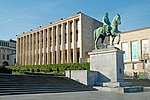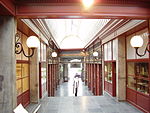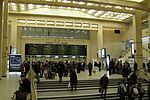Equestrian Statue of Albert I, Brussels
Buildings and structures in BrusselsCity of BrusselsMonuments and memorials in BelgiumStatues in BelgiumStatues of monarchs ... and 2 more
Tourist attractions in BrusselsUse British English from November 2022

The Equestrian Statue of Albert I (French: Statue équestre d'Albert I, Dutch: Ruiterstandbeeld van Albert I) is a bronze equestrian statue erected in Brussels, Belgium, in memory of King Albert I, third King of the Belgians. It was created by the sculptor Alfred Courtens in 1951.The statue stands on the Place de l'Albertine/Albertinaplein, at the point where the Mont des Arts/Kunstberg joins the Boulevard de l'Empereur/Keizerslaan, and a few tens of metres from the Royal Library of Belgium (KBR). This area is served by Brussels Central Station.
Excerpt from the Wikipedia article Equestrian Statue of Albert I, Brussels (License: CC BY-SA 3.0, Authors, Images).Equestrian Statue of Albert I, Brussels
Place de l'Albertine - Albertinaplein, Brussels Pentagon (Brussels)
Geographical coordinates (GPS) Address External links Nearby Places Show on map
Geographical coordinates (GPS)
| Latitude | Longitude |
|---|---|
| N 50.844166666667 ° | E 4.35625 ° |
Address
Albert Ⅰ
Place de l'Albertine - Albertinaplein
1000 Brussels, Pentagon (Brussels)
Belgium
Open on Google Maps











